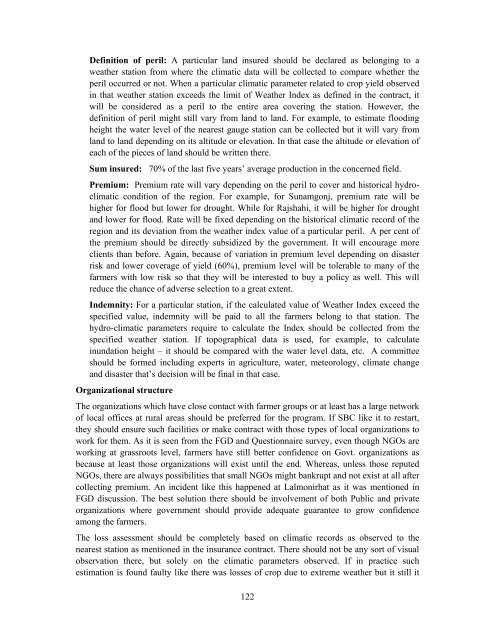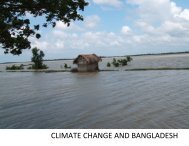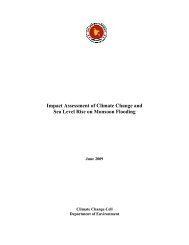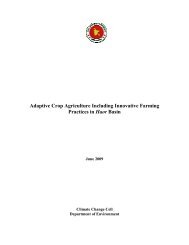Crop Insurance as a Risk Management Strategy in Bangladesh
Crop Insurance as a Risk Management Strategy in Bangladesh
Crop Insurance as a Risk Management Strategy in Bangladesh
Create successful ePaper yourself
Turn your PDF publications into a flip-book with our unique Google optimized e-Paper software.
Def<strong>in</strong>ition of peril: A particular land <strong>in</strong>sured should be declared <strong>as</strong> belong<strong>in</strong>g to a<br />
weather station from where the climatic data will be collected to compare whether the<br />
peril occurred or not. When a particular climatic parameter related to crop yield observed<br />
<strong>in</strong> that weather station exceeds the limit of Weather Index <strong>as</strong> def<strong>in</strong>ed <strong>in</strong> the contract, it<br />
will be considered <strong>as</strong> a peril to the entire area cover<strong>in</strong>g the station. However, the<br />
def<strong>in</strong>ition of peril might still vary from land to land. For example, to estimate flood<strong>in</strong>g<br />
height the water level of the nearest gauge station can be collected but it will vary from<br />
land to land depend<strong>in</strong>g on its altitude or elevation. In that c<strong>as</strong>e the altitude or elevation of<br />
each of the pieces of land should be written there.<br />
Sum <strong>in</strong>sured: 70% of the l<strong>as</strong>t five years’ average production <strong>in</strong> the concerned field.<br />
Premium: Premium rate will vary depend<strong>in</strong>g on the peril to cover and historical hydroclimatic<br />
condition of the region. For example, for Sunamgonj, premium rate will be<br />
higher for flood but lower for drought. While for Rajshahi, it will be higher for drought<br />
and lower for flood. Rate will be fixed depend<strong>in</strong>g on the historical climatic record of the<br />
region and its deviation from the weather <strong>in</strong>dex value of a particular peril. A per cent of<br />
the premium should be directly subsidized by the government. It will encourage more<br />
clients than before. Aga<strong>in</strong>, because of variation <strong>in</strong> premium level depend<strong>in</strong>g on dis<strong>as</strong>ter<br />
risk and lower coverage of yield (60%), premium level will be tolerable to many of the<br />
farmers with low risk so that they will be <strong>in</strong>terested to buy a policy <strong>as</strong> well. This will<br />
reduce the chance of adverse selection to a great extent.<br />
Indemnity: For a particular station, if the calculated value of Weather Index exceed the<br />
specified value, <strong>in</strong>demnity will be paid to all the farmers belong to that station. The<br />
hydro-climatic parameters require to calculate the Index should be collected from the<br />
specified weather station. If topographical data is used, for example, to calculate<br />
<strong>in</strong>undation height – it should be compared with the water level data, etc. A committee<br />
should be formed <strong>in</strong>clud<strong>in</strong>g experts <strong>in</strong> agriculture, water, meteorology, climate change<br />
and dis<strong>as</strong>ter that’s decision will be f<strong>in</strong>al <strong>in</strong> that c<strong>as</strong>e.<br />
Organizational structure<br />
The organizations which have close contact with farmer groups or at le<strong>as</strong>t h<strong>as</strong> a large network<br />
of local offices at rural are<strong>as</strong> should be preferred for the program. If SBC like it to restart,<br />
they should ensure such facilities or make contract with those types of local organizations to<br />
work for them. As it is seen from the FGD and Questionnaire survey, even though NGOs are<br />
work<strong>in</strong>g at gr<strong>as</strong>sroots level, farmers have still better confidence on Govt. organizations <strong>as</strong><br />
because at le<strong>as</strong>t those organizations will exist until the end. Where<strong>as</strong>, unless those reputed<br />
NGOs, there are always possibilities that small NGOs might bankrupt and not exist at all after<br />
collect<strong>in</strong>g premium. An <strong>in</strong>cident like this happened at Lalmonirhat <strong>as</strong> it w<strong>as</strong> mentioned <strong>in</strong><br />
FGD discussion. The best solution there should be <strong>in</strong>volvement of both Public and private<br />
organizations where government should provide adequate guarantee to grow confidence<br />
among the farmers.<br />
The loss <strong>as</strong>sessment should be completely b<strong>as</strong>ed on climatic records <strong>as</strong> observed to the<br />
nearest station <strong>as</strong> mentioned <strong>in</strong> the <strong>in</strong>surance contract. There should not be any sort of visual<br />
observation there, but solely on the climatic parameters observed. If <strong>in</strong> practice such<br />
estimation is found faulty like there w<strong>as</strong> losses of crop due to extreme weather but it still it<br />
122





